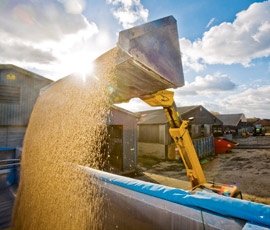Grain price gap between north and south widens

Feed wheat is worth almost £20/t more in Scotland than in the south east of England and the gap could widen.
As Farmers Weekly went to press this week, the ex-farm spot price ranged from £142/t in Kent and Sussex to £161/t in north-east Scotland.
Regional supply, demand and haulage costs are the main factors behind a gap which has been developing over the last two years as Scottish growers struggled to produce as much wheat as they would have wanted in 2012 and 2013.
Additional feed and distilling demand in the north of England and in Scotland have compounded the supply pressure in the last couple of seasons.
Differing pressures of arable fieldwork between regions could also account for some of the gap, with growers’ priority not being grain marketing as they concentrate on getting the 2014 crop in the ground.
| Ensus back in biofuel production |
|---|
| Production has restarted at Teesside-based biofuels producer Ensus following maintenance work by new owner CropEnergies. Commercial confidentiality means that the company will give no figures on how much grain is being taken in or how long it will take to reach full production at the plant which has a stop-start history. The move is likely to intensify the North’s wheat deficit and add to the upwards price pressure on feed wheat values in the region. German biofuels producer CropEnergies bought the Wilton plant in July this year and has promised an investment of £50m. The plant is one of the largest in Europe, with an annual capacity to make 400,000 litres of ethanol for greener road fuel, 350,000t of dried high protein animal feed (DDGS) and 300,000t of carbon dioxide for the food and drinks industry. |
However, the drop in prices compared with last year, along with a reluctance to over-commit grain are also important factors, leading to frustration for grain traders who would like to be moving more tonnage.
The wheat price rise has pulled more barley into feed rations, with a £10 to £15/t gap between feed barley and wheat prices in most areas.
However, in Northumberland and the Borders, barley is at a £30/t-plus discount to wheat.
Milling wheat premiums were being squeezed both by high demand for feed grain and by the better quality from the 2013 harvest, said Jack Watts, senior grains and oilseeds analyst at the HGCA.
Greater regional variations in price could be expected, but would be limited by import availability, said Mr Watts.
“We will continue to see regional variation in prices, there is the looming prospect of ethanol demand but this could be tempered by Ukrainian or EU maize imports, or by feed wheat imports from France or Denmark,” he said.
Openfield’s director of sales and trading Mark Worrell said that the trade had been pleasantly surprised by the size of the UK wheat crop, which is estimated to be between 12m and 12.6m tonnes against the 11m to 11.8m tonnes predicted before harvest.
Part of the price gap was the effect of expected demand from the Ensus and Vivergo bioethanol plants, said Mr Worrell.
